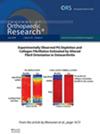The Effect of Cryopreservation on the Bone Healing Capacity of Endothelial Progenitor Cells in a Bone Defect Model
Abstract
Endothelial progenitor cells (EPCs) have proven to be a highly effective cell therapy for critical-sized bone defects. Cryopreservation can enable long-term storage of EPCs, allowing their immediate availability on demand. This study compares the therapeutic potential of EPCs before and after cryopreservation in a small animal critical-sized bone defect model. Five-millimeter segmental defects were created in the right femora of Fischer 344 rats, followed by stabilization with a miniplate and screws. The animals received 2 × 106 fresh EPCs (n = 7) or 2 × 106 cryopreserved EPCs (n = 9) delivered on a gelatin scaffold. Cryopreserved EPCs were stored for 7 days at −80°C prior to thawing and loading onto the gelatin scaffold. Biweekly radiographs were taken until the animals were euthanized 10 weeks after surgery. The operated femora were then evaluated using microscopic-computed tomography (micro-CT) and biomechanical testing. All animals treated with fresh (n = 7/7) or cryopreserved (n = 9/9) EPCs achieved radiographic union at 10 weeks. Animals treated with fresh EPCs had statistically significant higher radiographic scores at 2 weeks (p < 0.05) but showed no statistically significant differences thereafter (p > 0.05). Micro-CT analysis showed no statistically significant differences between the groups in bone volume (BV) or BV normalized to total volume (p > 0.05), with excellent bone formation in both groups. Finally, there were no differences in biomechanical outcomes between the groups (p > 0.05). These results demonstrate that cryopreserved EPCs are highly effective and equivalent to fresh EPCs for healing critical-sized bone defects in a rat model of nonunion.

 求助内容:
求助内容: 应助结果提醒方式:
应助结果提醒方式:


